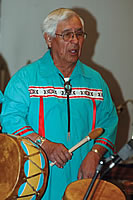
Arnold Herrera

Carlos Herrera

Paul Ortega
CD 1 Masters of New Mexico Traditional Folk Music - Hispanic and Native American
Raton Concert
Arnold & Carlos Herrera - Arnold and Carlos both play drums and sing on all tracks.
Arnold & Carlos Herrera - Arnold and Carlos both play drums and sing on all tracks.
- Buffalo Dance (Arnold Herrera) 2:06
This song is another part of the series of winter social dances that honor the buffalo. The dancers stand in two rows, in front and back, and the second chorus is choreographed with the steps that are also used in the matachina dance. Both the fast and slow buffalo dances honor the spirit of the Comanche tribe in their historic connection to the buffalo. - Fast Buffalo Dance (Arnold Herrera) 6:02
A winter social animal dance from Cochiti. This version written by Arnold asks for blessings in the Keresan language from all four directions, starting in the north, then to the west, then south and finally east. - Fast Eagle Dance (Arnold Herrera) 0:58
This song contains no actual words. It consists entirely of vocables or meaningless syllables. The particular vocables used in this eagle dance are those that are assigned to the Cochiti version of the eagle dance and that specially honor the great bird. - Round Dance (Carlos Herrera) 1:53
A social circle dance of Plains Indian origin that is often performed at pow-wows. This particular round dance was composed in the pow-wow style by Carlos Herrera.
Paul Ortega - Vocal, guitar, bass drum, and tambourine all tracks. - Back and Forth (Paul Ortega) 1:26
This is a social dance song that Paul learned from the San Carlos Apache of Arizona. - The Bird Song (Paul Ortega) 1:29
A song of thanks for the birds that have brought man many healing powers. - Moccasin Game Song (Paul Ortega) 1:56
The moccasin game is a gambling game of chance. Four moccasins are placed between two opposing teams. A ball is hidden by one side in one of the moccasins and the other side must guess which one. If they guess correctly, they gain points often represented by sticks and they get to hide the ball. If they guess wrong, they lose points or sticks and the other side continues to hide the ball. The game continues until one side has won all of the sticks. In this Mescalero Apache version of the song, the singer is asking the bee to help him guess correctly which moccasin holds the ball. - The Stomp Dance (Paul Ortega) 3:34
This dance song comes from the Indians who were relocated to eastern Oklahoma. Stomp dances are characterized by the call and response of the chorus.</p>
© 2011 New Mexico Arts, A Division of the New Mexico Department of Cultural Affairs, except where noted.
PO Box 1450, Santa Fe, New Mexico, Santa Fe, New Mexico.
505-827-6490/800-879-4278
www.nmarts.org | www.newmexicoculture.org
